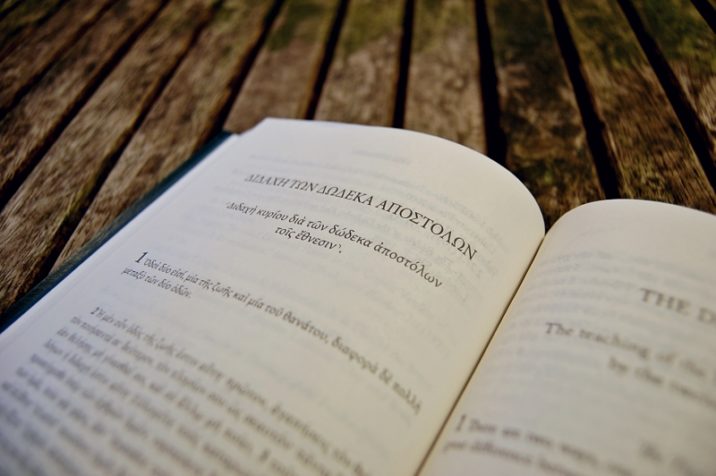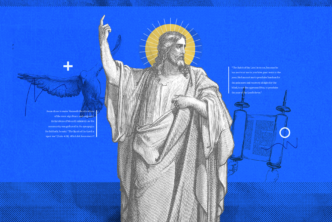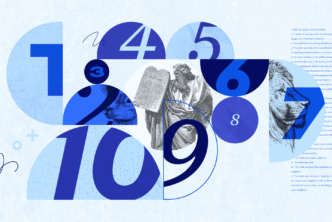Rev. Dr. Alan Garrow’s work recently enjoyed attention as the focus of the $1,000 Synoptic Problem Challenge—as taken up by Mark Goodacre on Bart Ehrman’s blog (we covered the debate here, here, and here). While having an interest in the Synoptic Problem, the primary focus of Garrow’s research is the Didache, or The Teaching of the Lord by the Twelve Apostles to the Gentiles. This article offers an overview of how his research impacts questions about that identity of this infamously enigmatic early Christian document.
Conservators working on an ordinary-looking renaissance painting discovered that, beneath various attempts at repair and restoration, lay a very different picture. A series of indicators suggested that, far from being the work of an inauspicious follower, they were dealing with an original Leonardo masterpiece. The painting, which had once sold for $45, subsequently achieved a record-breaking $450 million.
On the surface, the Didache, an early Christian text discovered in 1873, looks like a rather mundane document falsely claiming authorship by the Twelve Apostles. On closer inspection, however, certain elements suggest that, beneath the surface, lurks something much more special. This article notes five features of the Didache that suggest something of that star quality. Each feature offers a route to solving a New Testament puzzle that might previously have appeared impenetrable.
1. The Synoptic Problem
The Synoptic Problem, perhaps the most notorious of all New Testament puzzles, has resisted a satisfying resolution since it first became the subject of scholarly enquiry about 200 years ago. A development that might help resolve the question of the relationship between the Gospels of Matthew, Mark, and Luke would be access to new, relevant evidence.
The Didache is a potential source of exactly the type of new evidence required. The sayings in Did. 1.2–5a are strikingly parallel, but different, to those found in Matt 5.38–48 and Luke 6.27–36.
Didache 1.2–5a
1.2 Now the way of life is this: first, you shall love the God who made you; second, your neighbour as yourself, and everything that you would not have done to you, do not do to another.
1.3a The teaching of these words is this:
1.3b Bless those that curse you and pray for your enemies, fast for those that persecute you.
1.3c For what merit is there if you love those that love you? Do not even the Gentiles do the same? But love those who hate you and you will not have any enemy.
1.4a Avoid the fleshly and bodily passions.
1.4b If someone strikes you on your right cheek, turn the other also, and you will be perfect. If someone forces you to go one mile, go two. If someone takes your coat, give your shirt also. If someone takes away from you what is yours, do not ask for it back, since you cannot.
1.5a To everyone asking of you give, and do not ask for it back, for the Father wishes that gifts be given to all from his own bounty.
Some form of relationship between these three sets of sayings is unavoidable. And, if the original creative activity of the compiler of the Didache reappears in a Gospel, this will show that that Gospel depends on the Didache, rather than the reverse—in which case a solution to the Synoptic Problem should soon come into view.
Did. 1.2–5a is made up of two distinct sections. Did. 1.2 belongs to a version of the Two Ways ethical tractate, while Did. 1.3–5a is a catena of sayings inserted into the Two Ways to expand the meaning of the preceding commands. It is striking and remarkable, therefore, that the sayings in Did. 1.2 and Did. 1.3–5a appear in an integrated form in Luke 6.27–36. Not only that, the various small differences between Luke 6.27–36 and Did. 1.2–5a make consistent sense as arising from a Lukan attempt to create a smooth and integrated set of sayings out of the rough and awkwardly juxtaposed sayings in Did. 1.2 and Did. 1.3–5a. In the course of this “smoothing” process, Luke coins two distinctive expressions: “love your enemies” (by combining Did. 1.2 “love … your neighbor” with Did. 1.3 “pray for your enemies”) and the positive Golden Rule (Did. 1.2 has the negative Golden Rule, but most of the sayings in Did. 1.3–5a are positive). “Love your enemies” and the positive Golden Rule reoccur, of course, in Matthew’s Gospel (having not otherwise appeared in any more ancient context). At the same time, Matthew also shares a set of small unique agreements with Did. 1.2–5a. This invites an intriguing possibility: that the pattern of similarity and difference between Did. 1.2–5a, Luke 6.27–36, and Matthew 5.38–48 is a consequence of Matthew conflating Luke 6.27–36 with Did. 1.2–5a.

* For more on Matthew’s use of Luke, see Alan Garrow’s “Streeter’s ‘Other’ Synoptic Solution: The Matthew Conflator Hypothesis,” NTS 62.2 (2016). An illustrated presentation of this article is available at www.alangarrow.com/mch.html.
** For more on Didache 1.2–5a as a source for Luke and then for Matthew, see Alan Garrow “An Extant Instance of ‘Q,’” NTS 62.3 (2016). An illustrated presentation of this article is available at www.alangarrow.com/extantq.html.
2. The Thessalonians’ inexplicable grief
For some reason, Paul’s teaching on the events of the End caused the Thessalonians to grieve without hope over those who, having responded to Paul’s message, subsequently died. What could Paul have taught to create such an effect? More challenging still, what could Paul have said that, having caused the Thessalonians’ grief, was then susceptible to correction by the means Paul then offers in 1 Thessalonians 4.13–18? Any attempt at an imaginative reconstruction of Paul’s initial teaching would be bound to tie itself in knots. It is particularly striking, therefore, that the eschatological scheme set out in Didache 16.1–6, 8–9 provides what is required with exceptional precision. This scheme is capable of being read as suggesting that only those who remain faithful in the course of the final persecution will be saved. Further, it implies that only these martyrs may join the army of “holy ones” who accompany the Lord at his Parousia. If this were indeed the scheme taught to the Thessalonians by Paul, then this could explain why they believed that those who died before the final trial would be without hope—they would have missed the opportunity to demonstrate the reality of their faith through martyrdom. The really tricky part in all this, however, is that if Paul is to deal with their hopeless grief, he must steer the Thessalonians toward a different interpretation of the same tradition. Once again, Didache 16 fills the exacting brief. This scheme includes ambiguities at precisely such points as would allow Paul to redirect its narrative according to the pattern set out in 1 Thessalonians 4.15–17.
* For a fuller presentation of this proposal, see Alan Garrow, “The eschatological tradition behind 1 Thessalonians: Didache 16,” JSNT 32.2 (2009), also available via https://www.alangarrow.com/didache-and-paul.html
**‘… the fact that the Didache contains at least one tradition known to Paul’s churches is an exciting discovery, and it opens the way for finding out how much more of the Didache is pre-Pauline.” – Stephen Carlson, SBL Philadelphia, 2005
3. The Acts-Galatians Conundrum
According to Richard Pervo, it is “well beyond reasonable doubt”1 that the meeting described in Act 15.6–29 is the same as that described in Galatians 2.1–10, and yet, if this is indeed the case, there are some significant discrepancies between the two accounts. Acts records two visits to Jerusalem prior to the Acts 15 visit; Galatians 2 mentions, quite emphatically, only one. Acts records the creation of formal Apostolic Decree; Galatians mentions only a private conversation and a handshake. How are these differences to be explained? One option, commonly known as the “South Galatia Theory,” is that Paul wrote Galatians in the period between the Dispute at Antioch (Acts 15.1–2//Gal 2.11–14) and the Jerusalem Council (Acts 15.6–29). This theory has several important strengths but also some critical weaknesses. For example, why would Paul address his letter to “Galatians” before he could have founded churches amongst the people group most naturally identified by this title?2 Further, Paul presents his meeting with the Apostles (in Gal 2.1–10) in a way that is curiously reminiscent of the Council in Acts 15. This would seem to require Paul to offer a prescient description of what would happen at that future Council. Those scholars who reject the South Galatian theory, for these and other reasons, tend to favor a solution wherein Luke simply fictionalized various elements of his account. Indeed, the Fellows of the Westar Institute rate almost all of the relevant Lukan narrative as “Black/Improbable.”3 This is problematic inasmuch as it requires Luke to risk the credibility of his entire presentation by resting a key element of his case for gentile inclusion on a document that he knew to be fictional.
A route beyond this impasse is, however, available. All that is required is to allow that the apostles might genuinely have produced a decree at a council at which Paul was present—but that this decree was not as straightforwardly supportive of Paul’s position as Luke’s (partisan) account would have us believe. If it did indeed have such a double-edged quality, then the following sequence of events becomes possible:
- Responding to a predicted famine, Paul and Barnabas take a gift to Jerusalem (the famine relief visit), at which point the Pillar Apostles accept the non-circumcision of Antioch’s gentile believers.
- Later, visitors from Jerusalem to Antioch insist that gentile believers must be circumcised. Paul, confident of having recently secured the apostles’ support, agrees to take this dispute for their adjudication.
- The ensuing Council does not go as Paul expects. The apostles are persuaded to produce a compromise, a double-edged decree.
- Paul nonetheless elects to use this document as an instrument of mission in Galatia. He commends it to the new converts and emphasizes “edge one”—circumcision is not required for membership.
- Paul’s opponents come to Galatia in his wake. They trumpet Paul’s submission to the Jerusalem apostles and his acceptance of their decree. They also point out “edge two”—circumcision is ultimately required for salvation.
- The Galatians write to Paul cheerfully announcing that they are ready to take the next step in their newfound faith—as recommended by the document Paul himself commended to them and which has now been more fully explained by his “friends” from Jerusalem.
- Paul writes Galatians, a letter that makes full sense against a background in which the Galatians have been quickly persuaded (Gal 1.6) and “bewitched” (3.1) into believing that Paul was, after all, preaching the ultimate necessity of circumcision (5.11).
Under this scenario, there is a good reason why Paul does not appeal to the Decree—even while being fully aware of its contents. Once the Decree had been “turned” by his opponents, it would have become a weapon Paul must parry rather one he could have attempted to wield himself. Paul would also have had reason not to recall the events of the formal Council, since the story of the Council only serves to emphasize how he had submitted to the apostles and accepted their Decree. Instead, Paul would have a motive to highlight what had happened at the famine relief visit. There is every reason to expect that he would have been well received as the bearer of a generous gift—and it is entirely credible that his practice of welcoming uncircumcised gentiles would have gone uncontested on that occasion. Galatians 2.1–10 is best understood, therefore, as Paul’s attempt to present the famine relief visit as a “true council,” one at which the mind of the apostles was expressed independent of the machinations of the Judaizers. This would explain why the context of the Galatians 2.1–10 meeting matches that of the Acts 11.27–30 famine visit (preceded by a long absence from Jerusalem, and followed by the Incident at Antioch) while its content echoes that of a decision-making Council (circumcision is not required for Gentiles – viz Titus). By the simple expedient of replacing Luke’s single-edged Decree with a double-edged one, therefore, the Acts-Galatians conundrum is solved.
The only difficulty with this approach is that it relies on the notion that the Apostolic Decree could have had two specific, and perhaps seemingly incompatible, properties. First, it is required to have supported Paul’s position with sufficient force for him to commend it to the Galatians at the founding mission. At the same time, however, it is required to have been susceptible, in the hands of the Judaizers, to an interpretation wherein salvation could not be achieved without circumcision. Is it realistic to expect that such a document could ever have existed?
This is another point at which the Didache proves unexpectedly useful. It is double-edged in precisely the dimensions required:
- The Didache allows baptism without circumcision (Did. 1.1–6.3) and thence permission to participate in the Eucharist (cf. Did. 9.5). If participation in the Eucharist is regarded as the mark of full membership, then full membership may be achieved without circumcision.
- The Didache also warns, however, that “the whole time of your faith will be of no account unless you are perfected at the final hour” (Did. 16.2). Further, it describes “perfection” as something that may be achieved by keeping “the whole yoke of the Lord” (Did. 6.2). The Judaizers could then have argued that the whole yoke should be understood as meaning the whole Torah, including circumcision. This is not to suggest that that it must be interpreted in this way, merely that, in the hands of (potentially self-styled) ambassadors of the Jerusalem Apostles, a case persuasive to the neophyte Galatians could have been made.
This opens up another intriguing possibility: that the earliest form of the multi-layered Didache, or, to give it its full title, The Teaching of the Lord, by the Twelve Apostles, to the Gentiles, is the complete Apostolic Decree—a document partially recalled (in every sense) by Luke in Acts 15.23–29.
** A paper exploring the notion that the Original Didache is the Apostolic Decree was presented at the combined Paul and Acts Seminars of the British New Testament Conference, September, 2017. An illustrated video version is available at www.alangarrow.com/bntc2017
4. Paul’s Lost “Scripture”
On every other occasion where Paul uses the formula “ὡς/καθὼς γέγραπται,” he then goes on to quote a passage of the LXX. In 1 Corinthians 2.9, however, the closest LXX passage is Isaiah 64.4, where the similarities between the two are somewhat limited.
It is, of course, possible that, for some unknowable reason, Paul chose to misquote Scripture on this unique occasion. It is more likely, however, that “καθὼς γέγραπται” indicates Paul’s knowledge of these lines as a written source—the authority of which warranted the use of this formula. The seemingly unanswerable puzzle that remains, of course, is the identity of that document.
In the face of this conundrum, two features of the Didache are particularly striking. First, Paul attributes an extraordinarily high status to the Didache’s eschatological provisions (cf. The Thessalonians’ grief, discussed above). Thus, in 1 Thessalonians 4.15, he describes the Didache’s eschatological scheme as “a word of the Lord.” It is credible, therefore, that Paul would have thought it appropriate to use “καθὼς γέγραπται” when quoting from the Didache. The second striking feature of the Didache is that there are good reasons to suspect that its eschatological discourse originally concluded:
16.9 τότε ἀπελεύσονται οἱ μὲν πονηροὶ εἰς αἰώνιον κόλασιν, οἱ δὲ δίκαιοι πορεύσονται εἰς ζωὴν αἰῶνιον, κληρονομοῦντες ἐκεῖνα, ἃ ὀφθαμὸς οὐκ εἶδεν καὶ οὖς οὐκ ἤκουσεν καὶ ἐπὶ καρδίαν ἀνθρώπου οὐκ ἀνέβη, ἃ ἡτοίμασεν ὁ θεὸς τοῖς ἀγαπῶσιν αὐτόν.
16.9 Then the evil shall go to eternal punishment but the righteous shall enter into life eternal inheriting those things which eye has not seen and ear has not heard and which has not arisen in the heart of man. Those things which God has prepared for those who love him.
Given Paul’s knowledge of Did. 16, as evidenced in 1 Thessalonians, and given the high status he attributes to this tradition, it is credible that the Scripture he quotes in 1 Corinthians 2.9 is Did. 16.9.
* A detailed rationale for the reconstruction of the lost ending of the Didache is provided in Alan J P Garrow, The Gospel of Matthew’s Dependence on the Didache (LNTS 254, Continuum, 2004) 44–64.
5. What is Revelation?
The Book of Revelation is, perhaps, the New Testament text that bristles with more seemingly unanswerable puzzles than any other. Among this mass of imponderables lies one that has been, understandably, almost universally overlooked: why does Revelation have so many features in common with the Didache? Specifically, why are there are so many distinctive points of similarity in their ethics, eucharistic resonances, and eschatology?

* For more on the theory that Revelation was designed to be read in six separate installments, see Alan J P Garrow, Revelation (Routledge, 1997) and https://www.alangarrow.com/revelation.html.
** For more on the relationship between the Didache and Revelation see: “The Didache and Revelation” in J. A. Draper and C. Jefford’s (eds.) A Missing Piece of the Puzzle in Early Christianity (Atlanta: SBL, 2015). Text also available at www.alangarrow.com/didache-and-revelation.html.
What lies beneath?
As Salvator Mundi’s conservators gradually peeled away the later layers of retouching and restoration, they no doubt experienced a gradual process of realization. Little by little, as more and more clues accumulated, they came to dare to believe that they really were handling a lost Leonardo masterpiece.
The publications and papers noted above represent initial steps in an exploration of the possibility that the Didache, in its original form, is the complete Apostolic Decree: the letter to gentile believers composed by James the Brother of Jesus and the Jerusalem Apostles in 48 CE at the Council described, albeit in partisan fashion, in Acts 15.
** A detailed analysis of the Didache’s compositional history, including an estimate of its earliest form, may be found in Alan J P Garrow, The Gospel of Matthew’s Dependence on the Didache (LNTS 254, T&T Clark Bloomsbury, 2004).

Don’t forget that this is the last week to save 20% on any Logos base package.
- R.I. Pervo, Dating Acts: Between the evangelists and the apologists [Santa Rosa, Calif.: Polebridge Press, 2006], 80. The Acts version of the Jerusalem conference [Acts 15.6-29] is so similar to Paul’s version [Gal 2.1-10] that it has to be the same event [emphasis added] (D.E. Smith and J.B. Tyson [eds.], Acts and Christian Beginnings: The Acts Seminar Report [Polebridge Press, 2013], 333).
- E.P. Sanders, Paul: The Apostle’s Life, Letters, and Thought (Minneapolis: Fortress, 2015). In “Appendix II: Where was Galatia? Who were the Galatians?” pp. 748–77. Sanders discusses the identity and location of the audience of Galatians at length.
- Smith and Tyson eds., The Acts Seminar Report.







